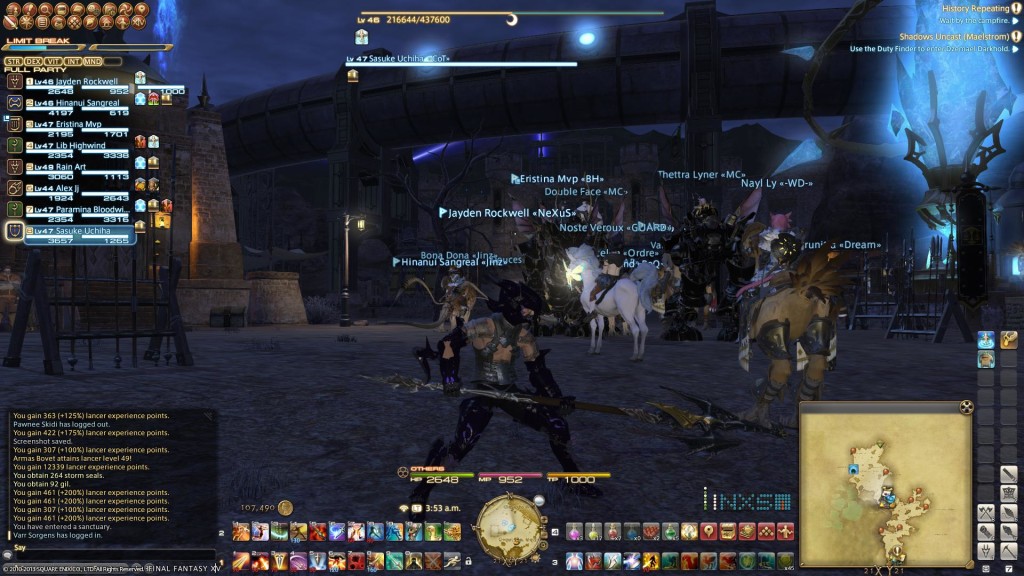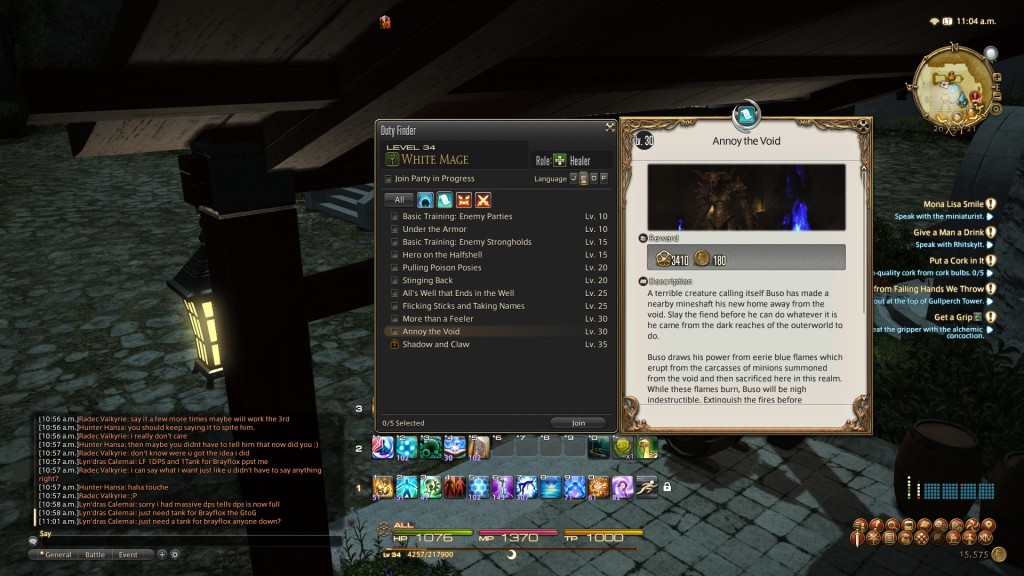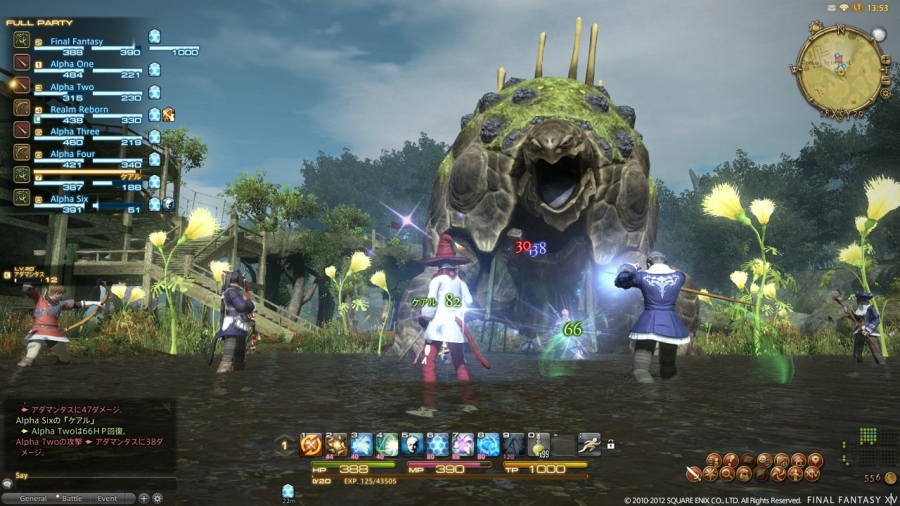Note: This series of two articles (the first of which released several Fridays ago) were written shortly, around the time when Final Fantasy XIV was released. I had high hopes for the game, and apparently it succeeded, but…it just wasn’t World of WarCraft. Much as I love Final Fantasy, the experience just rang too similar in the long run, and my family seemed to agree. We quit after about six months and simply jumped out of the game, waiting for the next WoW expansion. Honestly, I may return to it, you never know! Still, the game is a quality game, so here’s my thoughts on it. I’ve also added some new stuff, so it should seem fresh!
So what did Square-Enix do to capture my attention? Copied World of WarCraft to the letter, of course!
Maybe that’s a little unfair to them, but they certainly learned their lesson from the previous game. The user interface design copies a lot from WoW, of course:
You can move most of the elements on screen around as much as you’d like. Even if Square-Enix would NEVER let people create their own add-ons (due to their own problems with hackers and the like), they’ve given players the opportunity to move things around. If you want to place the menu options on the top left corner instead of the default bottom right (as shown here), feel free to do it. Want to add extra action bars? Go ahead! The game sets only 16 buttons due to the developer’s console roots – it is, after all, a PS3 game designed for a PS3 controller as well as a PC. Even so, Square-Enix lets you add more, and it’s wonderfully great. I tried using my PS3 controller, but my MMORPG habits feel too ingrained at this point to transition (even if this remains viable in most situations).
The map, especially, works brilliantly regardless of where you place it.The first press of the Map key will bring up the map, except it won’t obscure your view; the whole thing turns transparent enough so you can see through it, but also solid enough that you understand the geography at a glance. Press it again and it comes in full (as depicted here) if your objective remains unclear. I found this rather brilliant; as the game presents you with many locations with various silly, if thematically consistent names, it tells you what you need to know.
Quests and quest objectives helpfully appear on these maps, and you can zoom in and out freely to find their exact location. Due to the graphical splendor on display, you’ll find areas split into multiple sections, so it does sometimes become confusing where you need to go. Thankfully, pressing on a quest’s name on your Quest Log (helpfully located to the right side of your screen automatically, or within your Journal) will point out the exact location. Even then, the regular map will highlight the area where you need to travel (say, Central Thanalan) in order to find said quest. Even with the strange loading screen constraints on the world map, contrasted to WoW’s whole continent approach, I never found myself completely lost.
The item set up works especially well. If you see the place on the screen where it says “INXS” (not my favorite band), that’s a feature indicating how much of your bag’s full or not. It displays each slot in an entirely intuitive way without, say, needing to check your bag every five seconds when you’re near to filling it. Your equipment, furthermore, deposits into an Armory Chest separate from your other inventory, and it contains PLENTY of room, as well as categorizing all the different item types without your input. All of this makes your life in Final Fantasy XIV: A Realm Reborn incredibly efficient. You’ll read text, watch cutscenes, and fight things: exactly what you want to do, not micromanage everything while you level, or sell gear off (worth almost nothing to a vendor, actually!). If there’s one thing that requires adjusting, the chat window would be the place. I imagine this derives, again, from WoW, but I don’t quite understanding how to transition from Party to Free Company (guild) chat without clicking on the interface option. My brain will solve this over time.
Of course, I haven’t talked about the classes or the combat yet! The classes fit into the standard job roles you’d expect: Tank (Gladiator, Marauder), Melee DPS (Pugilist, Lancer), Ranged DPS (Archer, Thaumaturge) and Healer (Conjurer, Arcanist). Things get decidedly more complicated when you find out that Classes graduate into Jobs, more powerful versions of the eight base classes with additional abilities. Each one represents a class Final Fantasy role, from Warrior to Black/White Mages. Each also requires you to obtain level 30 in its primary, and 15 in another. Don’t worry; merely switching your weapon to a class-appropriate one will switch your class to another for yet some more level-building. The higher in level you have a class, the faster it makes the leveling curve for everyone else. It’s neat to have one character cross-pollinate their abilities between multiple classes, and it’s quite fun!
Reflecting Final Fantasy’s console origins, the game does not require what I’d call the “constant rotation button pushing” that WoW forces onto you at high levels of play. Everything’s got a long cooldown, and each class requires you use abilities at different time frames and different sequences. Some, like Pugilist, offer combo bonuses from stance transitions, while others enhance damage, add additional MP or TP (resource currencies), or provide some other strange effects. The game also eases you into these abilities slowly, unlocking them and also integrating them into each class questline (new quest every five levels, at least so far). The class quests especially test your mettle AND the primary role for your class, so prepare for a workout. You’ll feel powerful and unique right from the beginning!
If it were simply a game of fantastic looking whack-a-mole, though, all of this would mean nothing. Thankfully, even normal enemies present a challenge (especially in groups). Most of them attack you with AoE that you can avoid and dodge, given that you’re paying attention (rather than sitting there trying to hit the thing). If you don’t move out, it’s not likely that you will die, but you will take huge damage. Learn early, and learn often, or you will find yourself without the proper movement skills to progress in Final Fantasy XIV’s greater challenges.
And, if this isn’t enough, the game also works as a traditional Final Fantasy experience. Within the context of an MMORPG. With multiple people running around doing things. Truly, I’m not sure how they did it, but they did it. And partly they did it do to copying another developer outright! Think of it this way, though: what came before Final Fantasy XIV was, by all accounts, absolutely terrible. Imagine, they literally salvaged a working, functional game out of the mess that was Final Fantasy XIV. If you need to copy the granddaddy of modern MMORPG design, does any choice seem better than World of WarCraft? I think not.
We all need somebody to look up to, someone to emulate. Christians tell us who, exactly, they want to be right in their name. It was at Antioch that they were first called “little Christs”, due to their fervent desire to emulate their Lord and Savior. That is, in a sense, the whole point of Christianity – through God’s grace, become more like Christ.
You therefore, my son, be strong in the grace that is in Christ Jesus. 2 The things which you have heard from me in the presence of many witnesses,entrust these to faithful men who will be able to teach others also. 3 Suffer hardship with me, as a good soldier of Christ Jesus. 4 No soldier in active service entangles himself in the affairs of everyday life, so that he may please the one who enlisted him as a soldier. 5 Also if anyone competes as an athlete, he does not win the prize unless he competes according to the rules.
In 2 Timothy 5. the metaphors for that process of emulating Jesus are a soldier and an athlete. When it comes game time, athletes need to bring all their training unto that one day of reckoning; for a soldier, they must remain forever vigilant in case a war breaks out or someone seeks to do ill upon others. They must follow the rules, whether within the context of the game or in the context of law, but they must do either to the very best of their ability.
All of this requires not to isolate yourself, but to learn and adapt. Those who came before us teach us many lessons, and to learn requires using every tool at our disposal. Even as a child, we first learn how to speak by copying our parent’s seemingly strange sounds (at least at the time). To copy isn’t necessarily wrong; it’s only if you do nothing with that copying that brings the problems. And Final Fantasy XIV, for its part, copies all the right things and none of the wrong things. It remains unique for actually competing against a giant and winning (among certain demographics), at least establishing its own niche. That it is also based upon the mechanics of its successful predecessor, to me, just speaks of the power of iterative game design done right.
So yes, Final Fantasy XIV hits it out of the park by copying World of WarCraft, but it makes its own mark.



